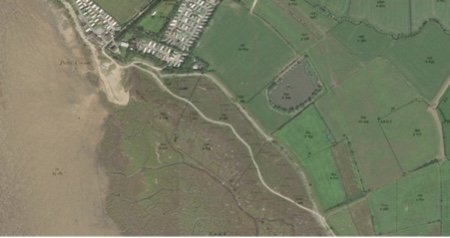Baxter’s Rails and the Belted Beauty
Wooden Posts near Potts Corner: From the authors collection
Shortly after setting off to walk from Potts Corner, Middleton towards Sunderland Point you will come across a series of regularly placed wooden stakes in the salt marsh. Hopefully they can be clearly seen in the photograph above.
Alternative view of the posts showing their original use as railway sleepers: From the author’s collection
Brian Lund who lives in Middleton has walked this route many times and wondered what the posts were for. He had read our article in the website magazine on Thomas Hinde (where we had identified that land belonging to Lancaster’s most infamous slaver Captain and investor had been put up for sale and include a parcel of land on the west shore salt marsh) and he contacted us and asked if we knew what the posts were for.
He suggested there may be a connection between the posts and Thomas Hinde’s land - could they be the markers for that same field.
Brian included a copy of the 1892-1914 ordnance survey 25 inch, which shows a field on the marsh.
1892-1914 ordnance survey 25 inch with permission of the National Libraries of Scotland
Brian then interestingly superimposed a google earth map over the marsh where we can see the field and notice the growth of the marsh and the access road to Sunderland Brows farm
Maps of Google Earth project
The posts are certainly very old - we were also intrigued and asked Alan Smith.
According to local tradition they are called ‘Baxter’s rails’. The posts are old railway sleepers sunk into the ground, and at one time had rails attached. These marked out land ownership and to ensure livestock grazing here were confined to this space.
Alan believes the rails disappeared years ago; he has no recollection of ever seeing them. Our other contacts were unable to add any more to Alan’s memories. The field is not marked on the older 1840’s OS map.
The working hypothesis currently is - all the marsh land in this area of the West Shore falls within the rights of the Lords of the Manor of Heysham. At some time in the past when land was being reclaimed for farming (as we also see on the eastern side of the Point) this parcel of land was enclosed and came into ownership of Sunderland Brows farm, part of it perhaps as early as 1800.
At some later point, perhaps early 20th century, the area of land was enlarged and the posts marked the new boundaries.
We understand Baxter families have been associated with the Middleton and the Brows farms for as long as the last 150 years. At some point to make the boundary more evident - or keep cattle in from straying or getting mixed up with cattle under different ownership the posts were sunk into the ground and rails fixed.
But we don’t know exactly when, or when the rails were removed, or who the Baxter was, as this is a common name in our area.
We are disappointed we have been unable to provide more information and give ourselves only five out ten. But were cheered up when Alan reminded us it is home to a colony of the rare Belted Beauty Moth.
Male Belted Beauty Moth: Photo credit Marcel Kárpati
And those posts have played a vital role as part of their micro-ecology and the survival of the colony
This is indeed a very rare moth. First recorded in Lancashire about 1900 in Crosby near Liverpool, and then later in 1918 when a female was spotted on Longton Marsh near Preston. For many years these remained the only locations for the moth in Lancashire. In the 1960’s and 70’s sightings of this national priority species were reported at the coastal locations near Lytham, next to Blackpool and at Sunderland Point.
Today their numbers have dwindled even further, and it is believed the only two known sites in England retaining a colony are on the Wirral in Cheshire and at Sunderland Point.There is a small colony in Wales and colonies of a sub-species on the west coast of Scotland.
Female Belted Beauty Moth: Photo credit Marcel Kárpati
Remarkably, the female is wingless, and therefore restricted to a small area unable to travel any significant distance and difficult to find.. The males are easier to locate as they rest during the day in visible locations such as fence posts. The green eggs as well as being laid in old seed heads of sea rush are laid in the crevices of fence posts.
The eggs of the species are so evolved they can survive tidal inundation.
Caterpillar of the Belted Beauty Moth: Photo credit Marcel Kárpati
The caterpillar likes to burrow in soft, dry sand in the summer to pupate and emerge the following year, climbing the stalks of plants and fence posts to reach warm sunshine
So, the old wooden posts of Baxter’s rails have provided resting stations, crevices for egg laying and climbing frames for the juvenile moths.
Gosh.
Help with history and scientific information on the moths was provide by North West Invertebrates to whom we give grateful thanks.
We are tickled pink to use that title for this article






